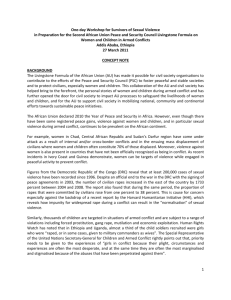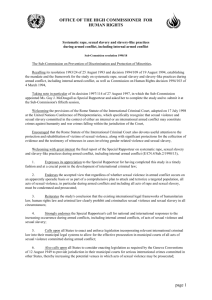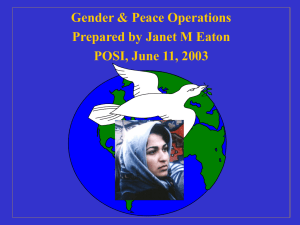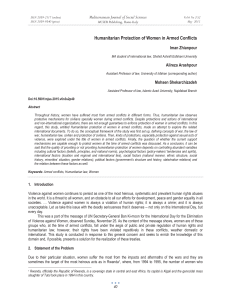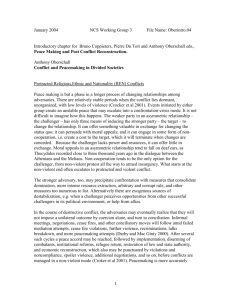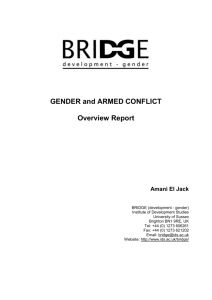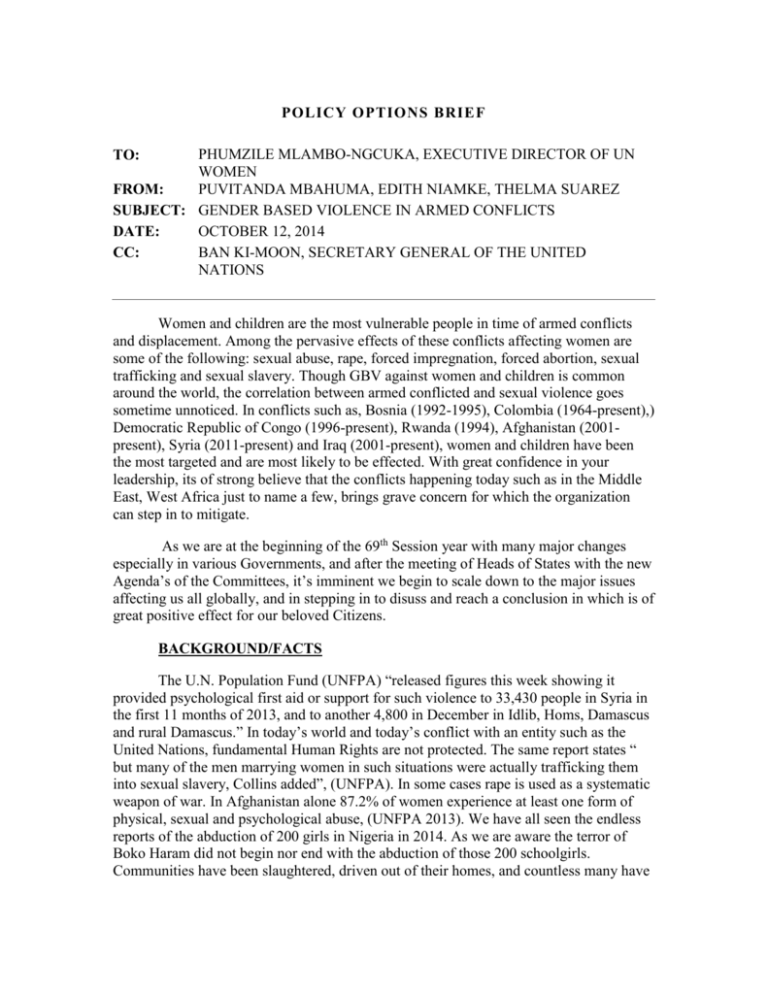
POLICY OPTIONS BRIEF
PHUMZILE MLAMBO-NGCUKA, EXECUTIVE DIRECTOR OF UN
WOMEN
PUVITANDA MBAHUMA, EDITH NIAMKE, THELMA SUAREZ
FROM:
SUBJECT: GENDER BASED VIOLENCE IN ARMED CONFLICTS
OCTOBER 12, 2014
DATE:
BAN KI-MOON, SECRETARY GENERAL OF THE UNITED
CC:
NATIONS
TO:
Women and children are the most vulnerable people in time of armed conflicts
and displacement. Among the pervasive effects of these conflicts affecting women are
some of the following: sexual abuse, rape, forced impregnation, forced abortion, sexual
trafficking and sexual slavery. Though GBV against women and children is common
around the world, the correlation between armed conflicted and sexual violence goes
sometime unnoticed. In conflicts such as, Bosnia (1992-1995), Colombia (1964-present),)
Democratic Republic of Congo (1996-present), Rwanda (1994), Afghanistan (2001present), Syria (2011-present) and Iraq (2001-present), women and children have been
the most targeted and are most likely to be effected. With great confidence in your
leadership, its of strong believe that the conflicts happening today such as in the Middle
East, West Africa just to name a few, brings grave concern for which the organization
can step in to mitigate.
As we are at the beginning of the 69th Session year with many major changes
especially in various Governments, and after the meeting of Heads of States with the new
Agenda’s of the Committees, it’s imminent we begin to scale down to the major issues
affecting us all globally, and in stepping in to disuss and reach a conclusion in which is of
great positive effect for our beloved Citizens.
BACKGROUND/FACTS
The U.N. Population Fund (UNFPA) “released figures this week showing it
provided psychological first aid or support for such violence to 33,430 people in Syria in
the first 11 months of 2013, and to another 4,800 in December in Idlib, Homs, Damascus
and rural Damascus.” In today’s world and today’s conflict with an entity such as the
United Nations, fundamental Human Rights are not protected. The same report states “
but many of the men marrying women in such situations were actually trafficking them
into sexual slavery, Collins added”, (UNFPA). In some cases rape is used as a systematic
weapon of war. In Afghanistan alone 87.2% of women experience at least one form of
physical, sexual and psychological abuse, (UNFPA 2013). We have all seen the endless
reports of the abduction of 200 girls in Nigeria in 2014. As we are aware the terror of
Boko Haram did not begin nor end with the abduction of those 200 schoolgirls.
Communities have been slaughtered, driven out of their homes, and countless many have
lost their lives. “Girls and young women belong in school and should stay there without
fear of violence, so they can play their rightful roles as equal citizens of the world”
(Ngeuka and Osotimehin, 2014).
UN Secretary-General Ban Ki-Moon even acknowledges “All of us-men and
women, soldiers and peacekeepers, citizens and leaders-have a responsibility to help end
violence against women”. In another western African country during its Civil War,
studies were conducted which have estimated the prevalence of rape to be between 9.2%
and 15%. These were false “survivors of different types of sexual violence, 77% had
experienced rape”, (Cohen and Green, 2011).
“During the first nine months of the year, 4,012 cases of sexual and gender based
violence were recorded through UNHCR’s protection monitoring system. The real figure
is likely to be much higher”, (UNHCR, Congo 2013). There has been, 41,225 cases of
GBV reports in one province of the Democratic of Congo (DRC) since 1998, with a
1,100 rape cases reported each month in the DRC according to the UNFPA, its evident
that the Violence Against Women and Children in Conflict, is an ever occurring issues
and we must deal with it on a micro-governmental level.
The new twist of using violence against women and children in conflict as a tactic
in war has put on more pressure for many nations to collectively address and resolve this
epidemic.
EFFECTS OF GBV IN ARMED CONFLICT
Gender Based-Violence has grieved effect on the judicial services, social services,
healthcare, and the unnoted indirect costs that vary from person to person and the
different international communities. The effects of GBV to the health of many societies
as a whole results in over spending of healthcare with not enough funding for everyone to
get the appropriate health services. The physical and sexual violence to our women and
children cause post-traumatic stress syndrome, low self-esteem and behavioral issues that
lead to sexual risk taking and victimization. “ Conceptions continue during conflict and,
with the absence of contraception and the pressures on women to support often highly
disturbed young men, the rate of pregnancy often rises. Women who are pregnant are
subject to potentially life-threatening complications, which cannot be laced on hold until
the conflict has finished. Most pregnancy-related emergencies can only be treated within
hospitals and, apart from the fact that hospitals may have been incapacitated; there is also
the great risk of travelling to hospital for treatment. The absence of functioning hospitals
leads to many maternal deaths an results in permanent disabilities from untreated
complications of pregnancy such as vesico-vaginal fistulae”(Southall, Early Human
Development 87).
As we continue to face together in trying to remedy of this international issue of
violence against women and children in armed conflicts, from the perspective of a Citizen
2
to a leader, this opportunity presents itself in giving some elements of response to
mitigate the epidemic.
POLICY OPTIONS
Health plays a major role in vast communities around the world. In armed conflict
the effects of violence against women and children has long lasting effects. Implementing
gender responsive care during and after is very important. Health programs evaluation
including needs assessments must be conducted (especially for those is rural areas and
conflict prone regions) for a better policy and the establishment for preventative and
curative interventions regarding sexual violence and other physical and or psychological
abuse, which is called Post Traumatic Stress Disorder, (PTSD).
The response of aid into these conflict prone areas has to alleviate with betterimproved communications and coordination between the Governments and the United
Nations and the Regional and International Organizations. Appropriate response time
and the care given to victims have to be consistent and ongoing, for better results and
caregiving of Women and Children in Armed Conflicts. As suggested by The InterAgency Standing Committee Task Force on the Gender and Humanitarian Assistance: the
sharing of information, identifying and mobilizing resources, prevention and response at
all stages of humanitarian action and Activities of inter-agency strategies and appeals just
to name a few, will be the beginning of Emergency Preparedness for Gender Based
Violence in Armed Conflicts.
PREVENTATIVE SUGGESTIONS
By recognizing the issue of Gender-Based Violence in Armed Conflicts,
providing support in communities especially those with the high rate of illiteracy is of
great need. Let’s give the opportunities to those who seem to never see a way out, let us
educate and notify the people that there are options and they are not alone. Most
importantly, the Nations must increase access to justice by improving laws and policies
not only for survivors but those who did not see a way out.
The response of the police, health aid, judiciary, legal aid, and forensic medicine
needs to be improved; the lack of action is why many Nations are still seeking answers to
concurrent issues. Let today end the excuse of letting perpetrators go free to perform the
same act again, it’s killing the Human Race. Let us hold our politicians, policy makers;
researchers and leaders in general, let us hold each other responsible. Lets provide
resources in these conflict-affected regions for aid.
3
4










